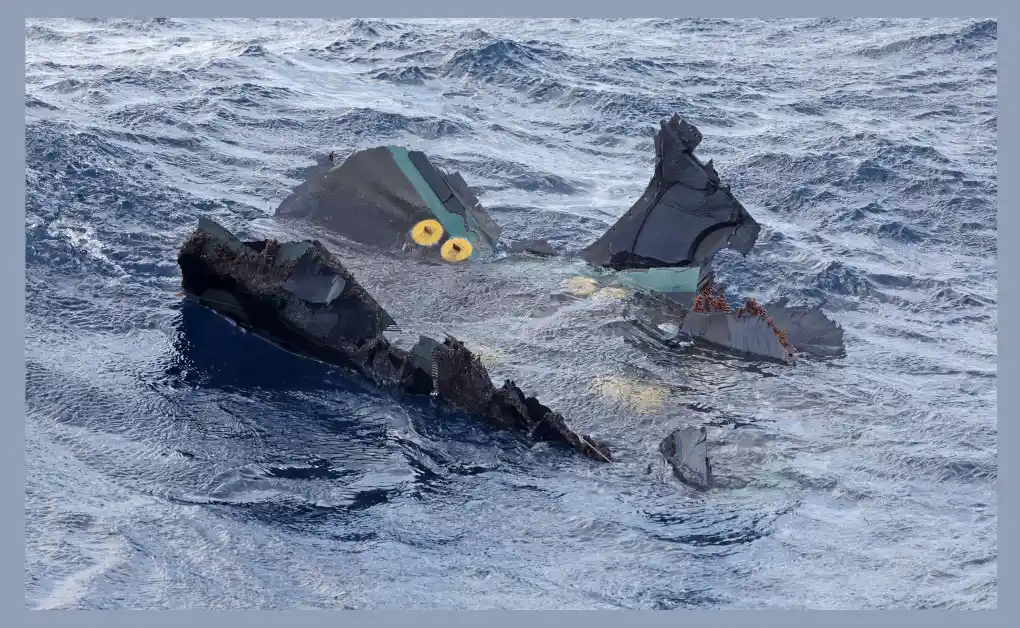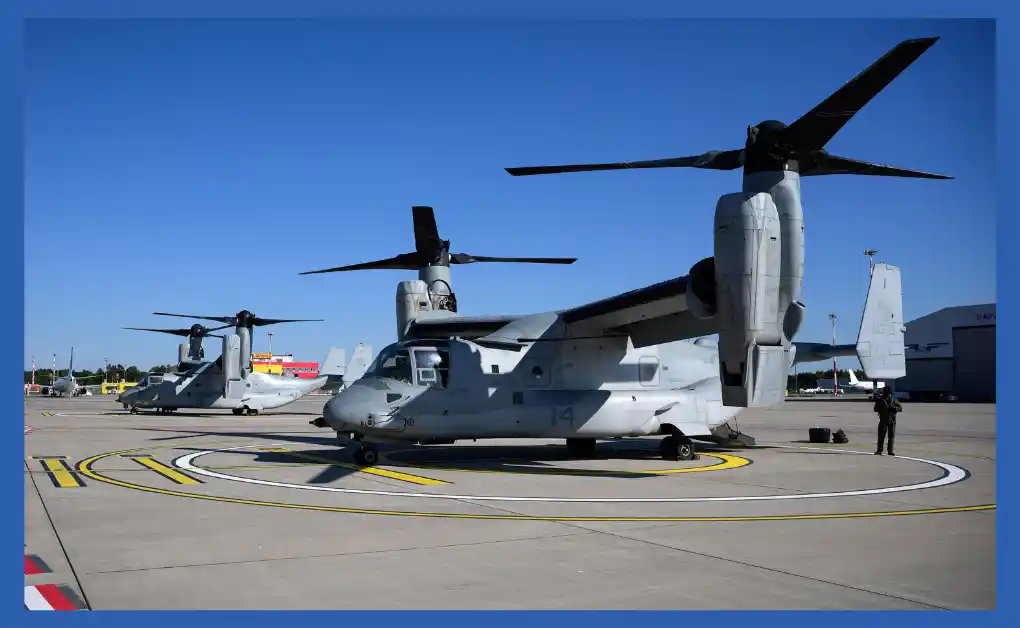A tragic Osprey crash last November off the coast of Japan claimed the lives of eight U.S. service members. An investigation by the Air Force has now revealed that the accident was caused by cracks in a critical gear and the pilot’s choice to keep flying despite repeated warnings. The crash, which involved a CV-22 Osprey aircraft during a military exercise, has since raised concerns about the safety of the aircraft and led to changes in operating procedures.

What Happened During the Osprey Aircraft Crash in Japan?
The Osprey aircraft crash occurred on November 9th, as the CV-22 Osprey was flying along Japan’s coastline, heading from mainland Japan to Okinawa Island. The unique aircraft, which can take off and land like a helicopter but fly like a plane, encountered trouble when cracks developed in a pinion gear inside the left proprotor gearbox. This component is crucial for the aircraft’s transmission, as it helps transfer engine power to the rotor blades.
Although the Air Force has pinpointed the pinion gear failure as the cause of the crash, investigators have not yet determined why the gear cracked in the first place. The report also found that important safety information about gearbox failures was not adequately communicated to flight crews, adding to the tragedy’s preventability.
The Pilot’s Decision and Missed Opportunities to Land
On the day of the CV-22 Osprey crash, the aircraft experienced several warnings indicating mechanical issues. The first sign of trouble was a vibration detected on the left side of the driveshaft, followed by vibrations in the pinion gear itself. However, the crew was unaware of these vibrations because the data could only be downloaded after the flight.
The first clear warning came as a “chip burn” alert, indicating that tiny metal fragments, or “chips,” were flaking off the gears inside the proprotor gearbox. While some chipping is common in rotary aircraft, the Osprey’s system is designed to burn off these chips before they cause damage. The aircraft received a total of six chip burn warnings during the flight, each providing an opportunity for the pilot, Maj. Jeff Hoernemann, to land as a precaution. However, the investigation found that he chose to continue the mission, prioritizing the military exercise over the evolving mechanical problems.
Six Opportunities to Prevent the Osprey Aircraft Crash
The Air Force investigation pointed out that there were six missed opportunities for the pilot to land safely. After the third chip burn warning, the aircraft was just 10 miles from an airfield on the Japanese mainland, which could have allowed for an emergency landing. Official guidelines recommended landing “as soon as practical” after three chip burns, but the decision was left to the pilot’s discretion.
The situation escalated further after the fourth and fifth warnings. When the sixth warning came, indicating that the chips could no longer be burned off, the advisory changed to “land as soon as possible.” Despite this, there was still no urgency from the crew, even as they approached an airfield at Yakushima just half a mile away. Instead of landing immediately, they waited for local air traffic to clear the runway.
The Final Moments Before the Plane Crash
Three minutes before the crash, the Osprey gave a final “chip detector fail” warning, signalling that the detector was overwhelmed by the volume of metal fragments. Maj. Hoernemann dismissed the warning, thinking it was a false alarm due to a faulty detector. However, the pinion gear inside the proprotor gearbox had already begun to break apart. The resulting damage stopped the left proprotor mast from turning, leading to a catastrophic failure of the aircraft’s transmission system.
Within seconds, the Osprey lost control, rolling violently and inverting twice. The left engine caught fire, and the aircraft crashed into the water, resulting in a devastating military plane crash in Japan that killed all eight service members on board.
Who Were the Victims of the Osprey Aircraft Crash?
The crash claimed the lives of:
- Maj. Eric V. Spendlove, 36, of St. George, Utah
- Maj. Luke A. Unrath, 34, of Riverside, California
- Capt. Terrell K. Brayman, 32, of Pittsford, New York
- Tech. Sgt. Zachary E. Lavoy, 33, of Oviedo, Florida
- Staff Sgt. Jake M. Turnage, 25, of Kennesaw, Georgia
- Senior Airman Brian K. Johnson, 32, of Reynoldsburg, Ohio
- Staff Sgt. Jacob M. Galliher, 24, of Pittsfield, Massachusetts
- Maj. Jeff Hoernemann, 32, of Andover, Minnesota
Their loss is a sombre reminder of the risks faced by military personnel and the critical need for improved safety protocols.
Changes in Protocol Following the Osprey Aircraft Crashes
The fatal Osprey aircraft crash was not an isolated incident; it marked the fourth fatal Osprey accident in the past two years. The investigation has prompted the Air Force to implement stricter safety protocols. Crews are now required to land “as soon as practical” after a first chip burn warning and “as soon as possible” after a second warning. Additionally, the military is developing new technology to provide real-time vibration data to pilots during flight, improving their situational awareness.
The Pentagon’s program office for the V-22 Ospreys was also found to have failed to communicate the risks associated with gearbox failures to flight crews. This oversight has led to changes in how safety information is shared and acted upon within the fleet.
Japan’s Response to the CV-22 Osprey Crash
Following the CV-22 Osprey crash in Japan, the Japanese military took immediate action to ground its fleet of Ospreys and implemented tighter flight restrictions. These included operating only within 30 minutes of a landing location and conducting more frequent chip checks and maintenance. The safety measures introduced by the U.S. military are now mirrored by Japan to ensure the highest level of safety for their Osprey operations.

Japanese Defense Minister Minoru Kihara expressed confidence in the aircraft’s safety, stating, “I believe Ospreys have no safety problems,” while adding that Japan would continue working closely with the U.S. military on safety measures.
The Osprey’s Safety Record and Ongoing Concerns
The Osprey aircraft crash near Japan has sparked debates within the military regarding the aircraft’s future. While the V-22 Osprey is valued for its versatility, allowing it to perform tasks that would otherwise require multiple aircraft, its safety record has raised concerns. With four fatal crashes in two years, the aircraft’s ability to handle long missions and mechanical issues is under scrutiny.
The Osprey, co-produced by Bell Flight and Boeing, has a history of mechanical challenges, including gearbox issues and previous crashes linked to equipment failures. The recent plane crash in Japan military settings has only intensified calls for closer evaluation of the aircraft’s safety protocols.
Pilot Culture and Mission-First Mentality
The Air Force report also shed light on the decision-making process that contributed to the crash. Lt. Gen. Michael Conley stated that the pilot’s instinct to complete the mission played a role in the choices made during the flight. This “mission-first” mentality may have influenced Maj. Hoernemann’s decision to keep flying despite the warnings.
The investigation highlighted the need for a culture shift in decision-making, where safety is prioritized over completing the mission, especially when dealing with signs of mechanical failure. The report also noted that the co-pilot did not fully express his concerns during the flight, which may have contributed to the delay in taking appropriate action.
Conclusion: Lessons from the Osprey Crash Off Japan
The tragic Osprey crash near Japan serves as a stark reminder of the importance of acting on early warning signs and ensuring that safety information is effectively communicated to flight crews. Similarly, the recent plane crash in Brazil highlights the ongoing need for rigorous safety standards and timely maintenance checks to prevent such devastating accidents. As the military continues to implement changes and improve safety measures, the goal is to prevent future incidents and protect the lives of service members.
FAQs
What caused the Osprey crash near Japan?
The crash was caused by cracks in a pinion gear within the proprotor gearbox, combined with the pilot’s decision to continue flying despite multiple warnings.
How many Osprey aircraft crashes have occurred recently?
There have been four fatal Osprey crashes in the past two years, leading to increased scrutiny of the aircraft’s safety.
What changes have been made following the CV-22 Osprey crash?
Crews are now required to land as soon as practical after the first chip burn warning and as soon as possible after a second. Additionally, new real-time monitoring systems for vibration data are being developed.
How did Japan respond to the plane crash?
Following the military plane crash in Japan, the Japanese military grounded its Osprey fleet and adopted stricter safety measures similar to those implemented by the U.S. military.
Who were the victims of the Osprey crash?
The crash resulted in the deaths of eight service members, including pilots and crew, from the Air Force Special Operations Command.